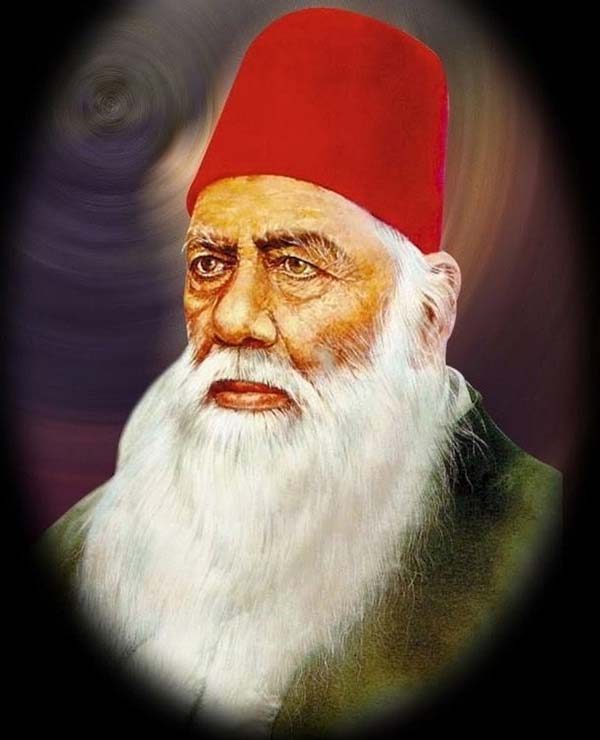by Khursheed Wani

October 17 evening was unique at picturesque Pahalgam. The fading hoardings with greeting messages for Amarnath pilgrims were out of sync with the deserted streets and empty hotels. The Lidder rivulet flowed with relative calm and the slanting evening rays painted a yellowish hue on the Valley preparing to enter into a long winter phase.
I was directed by the hoardings of a different theme to my destination, a group of hotels in actual Pahel-gham village, away from its commercial exterior. The hoardings flashed the picture of legendary Muslim reformist Sir Syed Ahmad Khan, whose 200th birth anniversary was being celebrated. I was going to be part of the wonderful event for my deep association with Aligarh Muslim University (AMU), the alma mater founded by Sir Syed at a time when Muslims of the sub-continent were facing an existential crisis.
Kashmir Aligs—a loose group created by a battery of AMU alumni, had decided to celebrate the bicentenary in a befitting way. Some enthusiastic Aligs from south Kashmir took the responsibility to host the event. They created a WhatsApp group to spread the word and online contributions followed. Every participant contributed for the overnight stay and food. Some deeply-attached alumni arrived with their families. The sight of chirping, sporty kids turned out to be another stress-buster.
The present day AMU may not form a role model. It is struggling with challenges within and without and being christened as a ‘decaying institution’ may not be altogether misplaced. But that does not blur its contribution to the uplift of Muslims in the sub-continent.
The hosts were meticulous in recreating an Aligarh ambience. They got matris (a unique bread taken with omelet at any time on AMU dhabas, especially in breakfast) couriered from Aligarh and the hotel chefs had a tough time to prepare the traditional treat for every guest on arrival.
As it grew darker, the temperature steadily plummeted thanks to the cold breeze emanating from Lidder and overlooking conifer-filled mountains. Some of the participants began listening to the music of their vibrating teeth. The hosts ordered firewood and lit the campfire in the lawns of the spacious hotel. The guests continued arriving till late in the night.
When the arrivals stopped, the guests were guided to a bedecked canopy adorned with Sir Syed’s pictures. Then came the movement when everyone got emotionally surcharged as the hosts played the AMU tarana – yeh mera chaman hai mera chaman mein apnay chaman ka bulbul hun. The Aligs have a spiritual connection with the song penned by legendary Asrarul Haq Majaz. Everyone was on his feet, clapping when the last lines of the anthem were being played.
Kashmir is one of the places that boast thousands of AMU alumni who have contributed in shaping up the place and its uplift in diverse fields. If there was any renaissance in Kashmir, especially in the Muslim community, after 1947, the AMU played a vital role in shaping it. From Sheikh Abdullah who post-graduated in Chemistry in the 1920s, to the hundreds of scholars presently pursuing their education in the expansive university, every individual who has returned from Aligarh has laid some footprint in the society. The Kashmir University and the High Court have a predominant majority of AMU alumni. The fields of medicine, engineering and fine arts are no exception. It requires detailed and exhaustive research to assess the contribution of the AMU in bringing about a substantive change in the status of Muslims in J&K.
The Sir Syed Day celebration is symbolic. A refrain to get together and remember the good olden days spent in the lap of the alma mater. I don’t know whether the alumni of other universities have the same bonding, but for Aligs, the association is unique. During the introduction phase, everyone recalled his enrolment number, a unique possession that gives a hint of the era one has been on the rolls of the varsity.
There were no speeches or discussions, of course, in the wake of political sensitivities linked to Kashmir and its thinking natives. The sleuths of the intelligence wing of the police, nevertheless, made some rounds to know if anyone spoke anything, notwithstanding the state’s intelligence chief, himself a diehard Alig, was among the first to enrol for the event but eventually couldn’t make it due to some preoccupation.
The organizers beamed a half-an-hour documentary on the life and contribution of Sir Syed. I couldn’t resist drawing parallels between the time Sir Syed found himself in and the Muslims of Kashmir find themselves now. There is a looming threat to their existence, leave alone the Aligs’ hangout future, progress and development. All intellectuals and people of nerve and grit, have a responsibility to rise to the occasion and find ways and means to guide the society. The Aligs are no exception. They have an added responsibility because they have been nourished at the alma mater founded by Sir Syed Ahmad Khan.
The present-day AMU may not form a role model. It is struggling with challenges within and without and being christened as a ‘decaying institution’ may not be altogether misplaced. But that does not blur its contribution to the uplift of Muslims in the sub-continent. Sir Syed’s story encourages for institution building. We in Kashmir have lacked this trait and during the past few decades, we have spent our energies to destroy the existing institutions. Encouragingly, I found everyone in the gathering, aware of the ground realities and ready to contribute for the purpose, in individual or collective ways. Let the ideas float and concretize.
(The author is a senior journalist)















